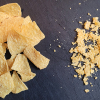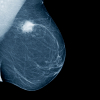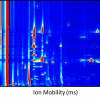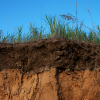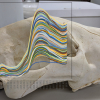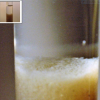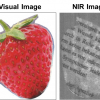Tom Scherzer, Gabriele Mirschel and Katja Heymann
Leibniz Institute of Surface Modification (IOM), Permoserstr. 15, D-04318 Leipzig, Germany. E-mail: tom.scherzer@iom-leipzig.de
Introduction
Polymer coatings play an important role in our daily life. They are widely used in numerous applications, which range from decorative and protective coatings to coatings with specific functional properties. Polymer coatings can be made by various technologies such as drying of solvent- or water-based lacquer formulations, reaction of two-component systems, or thermal curing of resin mixtures. A particularly efficient and versatile method to produce polymer coatings is UV curing of multifunctional monomers and oligomers such as acrylates, methacrylates, epoxies and vinyl ethers. This method is characterised by high production speeds and superior environmental sustainability as well as producing a wide range of potential properties and the high quality of the resulting coatings.
The functional properties of UV-cured coatings strongly depend on several process parameters. The two most important variables are the conversion (degree of cure) of the functional groups and the thickness of the applied layer. For instance, scratch and abrasion resistance depend on the hardness of the layer, which is directly related to the degree of cure. Coatings for exterior applications have to show a high resistance against weathering, which can be only achieved if the conversion is largely completed. Insufficient conversion also increases the soluble fraction, which can be extracted from the coating and is one of the most critical parameters for packaging materials (e.g. for sensitive goods such as foods, pharmaceuticals etc.). A sufficient conversion is also indispensable for further processing of the coating, e.g. with respect to wipe resistance. Furthermore, a number of functional and other application properties (e.g. barrier behaviour, mechanical resistance, hiding power etc.) strongly depend on the thickness of the coating.
On the other hand, the extent of the conversion depends on numerous key variables such as the intensity of the incident UV light, the line speed, the composition and the homogeneity of the reactive formulation, the ambient conditions during irradiation (temperature, inertisation, humidity etc.) and other factors. Whereas some of them can be easily controlled, even under the conditions of technical UV curing, this is hardly possible for effects like ageing, pollution or failure of UV lamps, differences between various batches of the lacquer formulation, or other unexpected influences. The thickness of the applied coating may fluctuate as well due to variations of viscosity, temperature, line speed etc.
In order to ensure a constantly high quality of the manufactured products, the compliance of the actual level of the conversion and the thickness of the coating with the requirements determined by the specific application has to be controlled continuously. In the past, near infrared (NIR) spectroscopy has been proven to be a powerful technique for the monitoring of various polymerisation processes. However, the typical thickness of UV-cured coatings is in the range of a few micrometers only and hence much lower than the sample thickness used in most other applications of NIR spectroscopy. In combination with the low absorptivities of bands in the NIR, the low thickness might be expected to make the analysis of such samples under process conditions a difficult task. However, it will be shown here that NIR reflection spectroscopy is able to follow even small variations of both the conversion and the thickness of thin coatings and that it accordingly can be used as an efficient in-line measuring method.









